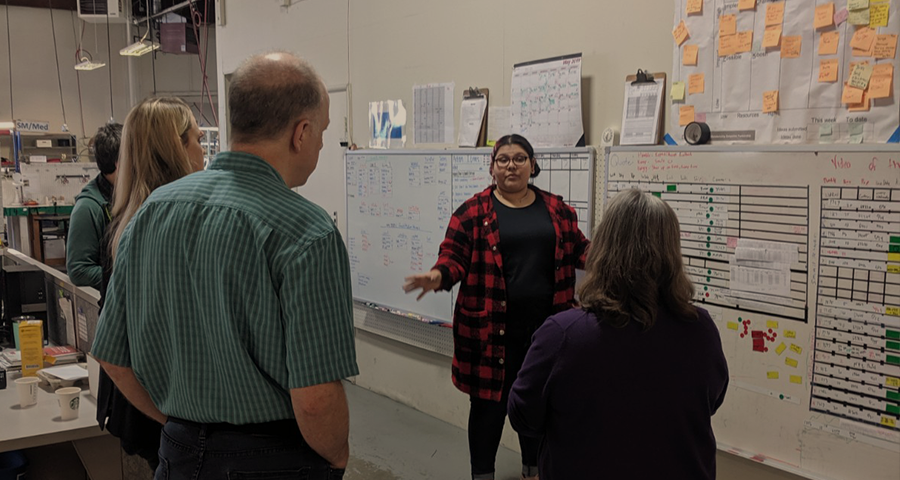Leading people can be challenging, and following a leader can feel frustrating as well. We’re all just trying to do our best at work, whether we’re owners, managers, or employees. Everyone has challenges in the workplace and no workplace is perfect.
Creating a culture that fosters employee engagement is not something you can just do using a couple easy tricks. It is a process of continuous improvement, and every day counts in getting you closer to your cultural ‘true north’.
That said, if you have no idea where to start improving, it’s worth considering some of these approaches, and applying them to the team you are leading or to your interactions with fellow employees. We all have to start somewhere!
Pay (and Promote) for Productivity – Only for Productivity
Each employee’s pay should be determined by his or her contribution to the company, with pay increases based solely on productivity – not previous education or experience or other subjective measures like teamwork or attitude. This does not mean that education, experience, teamwork, and attitude don’t affect productivity: they certainly do! This also does not mean that employees should be paid on a ‘per piece produced’ basis. Instead, employees should be paid based on agreed-upon, transparent, simple and objective measures of work contribution.
Like pay increases, promotions are based solely on work contribution, with the highest contributor being the top candidate for an open position. The top contributor should be next in line for an open position, and should not be passed up unless they do not want the position.
The idea here is to find an objective and transparent way to pay and promote your employees so that they feel free to do what they are paid to do – produce – without worrying about favoritism, office politics, and other influencers that are out of their control.
This helps an employee feel secure and valued for their work. They will also sense that they work for a company that treats their employees fairly, which will increase trust, allowing them to relax and focus on work.
Full Employment
If you pay based on productivity, some employees will start overproducing to make sure that their pay and promotion opportunities are ‘secured’. As a manager, you might welcome this type of over-achieving at first, but in the long run, this may lead to employee burnout, which will decrease engagement. One reason employees set higher and higher bars for themselves is because they may be feeling insecure about the future. They might be thinking, ‘what if there is a layoff?’ or ‘what if they cut back hours when we are slow?’ They would like to be the last ones to get cut!
You can settle these fears by ensuring the steady employment of every competent employee. Management has the responsibility to plan production so as to generate year round work for everyone. This can be achieved through buffering, overtime, flexible schedules, and many other strategies to keep your employees fully and steadily engaged.
Full employment increases morale, security, and loyalty, as well as well as giving employees space to learn, think creatively, and maintain a work life balance.
Respect Your Employees as You Would Respect Yourself
We may work for a paycheck. We may work because we are good at it. But most of the time, we work because we seek the admiration and respect of others. It is not enough to be encouraging (though it certainly helps!) – your employees want to feel like you respect them as people, and value their unique talents and contributions. A large part of respect is seeing ALL levels of employees and hearing them (really listening with intent to take action) when they have an idea or concern.
That doesn’t mean you need to say yes to every idea or solve every problem, but listening helps give your employees the space and freedom to express themselves without repercussions.
A culture of mutual respect creates the space for your employees to care for themselves and others, and for creative ideas to blossom! It also helps us learn from each other, as every person has something unique to teach us, no matter what their education, life, or work experience. Create a culture of mutual respect and watch employee engagement skyrocket!
Total Responsibility, Transparency, and Recognition
An employee cares more about their work when everyone knows it is their work. Another way of saying this is that no matter what the job, employees take pride in their work. That is why it is important to clearly state who is responsible for what, even if the job requires a team. Transparency in job roles and responsibilities ensures that no one will steal anyone’s thunder when it is review time.
People are naturally competitive. Even if they are competing against their past performance, people like to see (and want others to recognize) when they have improved. If responsibilities are muddied or unclear, then positive feedback and recognition will be diluted, reducing its positive effect on an employee’s pride in their work. Pride fosters motivation, and motivation is key to engagement, so make sure that your employees have clear lines of responsibility and that you recognize them for their good work.
Fun-Mongering
All work and no play makes for a very dull workplace. So have some fun! Your fun can be as unstructured as going out for ice cream with a fellow employee or as structured as a company retreat somewhere inspiring. We spend so much of our time at work these days that it’s important to have a little lightness in your long work day. How about a 15-minute hacky-sack circle in the back parking lot? A birthday party or a baby shower? Do something different, and let your minds and bodies relax, because these are the things we often look forward to, and they help us build relationships and workplace culture.
Many of these ideas come from the teachings of Clair F. Vough and his book Tapping the Human Resource: A Strategy for Productivity. Although this book was published in 1975, its lessons apply to manufacturing today. Clair’s teachings are indeed ‘true north’ and you might think, ‘this would never work in my company…’ Give them a chance, shift your thinking, and make these lessons work for you. Your employees will thank you!





